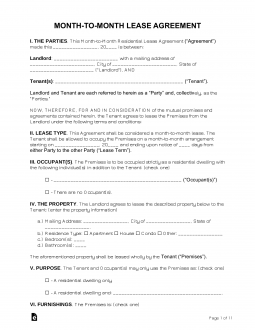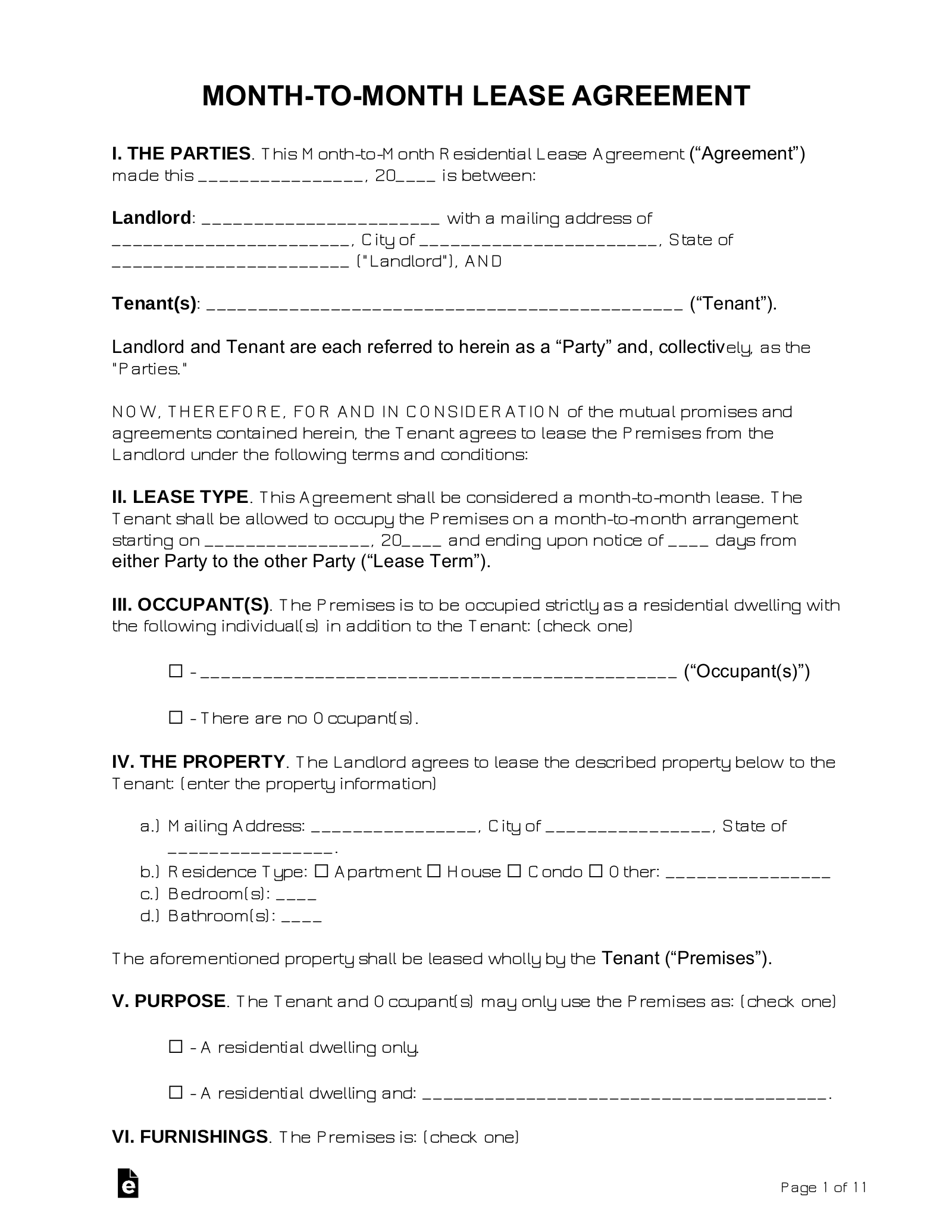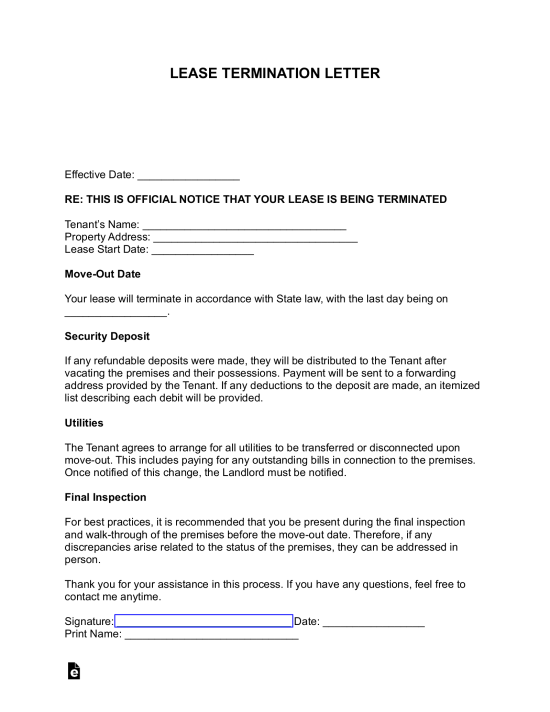Updated March 16, 2024
A month-to-month rental agreement, or tenancy-at-will, is a short-term lease between a landlord that rents space to a tenant, which can be terminated with 30 days’ notice (see required termination period). A tenant under a month-to-month lease has the same rights and responsibilities as a tenant under a standard lease.
Increasing Rent
A landlord must provide at least 30 days’ notice before increasing the tenant’s monthly rent with an increase notice.
Terminating a Month-to-Month Lease
To terminate a lease, either party must send a termination notice at least 30 days prior to canceling a month-to-month lease.
By State
- Alabama
- Alaska
- Arizona
- Arkansas
- California
- Colorado
- Connecticut
- Delaware
- Florida
- Georgia
- Hawaii
- Idaho
- Illinois
- Indiana
- Iowa
- Kansas
- Kentucky
- Louisiana
- Maine
- Maryland
- Massachusetts
- Michigan
- Minnesota
- Mississippi
- Missouri
- Montana
- Nebraska
- Nevada
- New Hampshire
- New Jersey
- New Mexico
- New York
- North Carolina
- North Dakota
- Ohio
- Oklahoma
- Oregon
- Pennsylvania
- Rhode Island
- South Carolina
- South Dakota
- Tennessee
- Texas
- Utah
- Vermont
- Virginia
- WA – Seattle
- WA – Outside Seattle
- Washington D.C.
- West Virginia
- Wisconsin
- Wyoming
By Type (3)
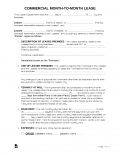 Commercial Month-to-Month Lease
Commercial Month-to-Month Lease
Download: PDF, MS Word, OpenDocument (10 pages)
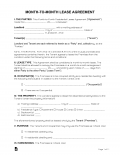 Residential Month-to-Month Lease (comprehensive)
Residential Month-to-Month Lease (comprehensive)
Download: PDF, MS Word, OpenDocument (11 pages)
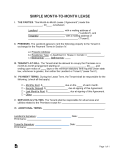 Residential Month-to-Month Lease (simple)
Residential Month-to-Month Lease (simple)
Download: PDF, MS Word, OpenDocument (1 page)
Table of Contents |
Required Termination Periods
| State | Minimum Termination Required | Statute |
| Alabama | 30 days | § 35-9A-441 |
| Alaska | 30 days | § 34.03.290(b) |
| Arizona | 30 days | § 33-1375 |
| Arkansas | 30 days | § 18-17-704 |
| California | 30 days for tenancy 1-year or less, 60 days for tenancy of more than 1-year | § 1946 |
| Colorado | A tenancy for one year or longer, three months; A tenancy of six months or longer but less than a year, one month; A tenancy of one month or longer but less than six months, ten days; A tenancy of one week or longer but less than one month, or a tenancy at will, three days; A tenancy for less than one week, one day. | § 13-40-107 |
| Connecticut | 3 days | § 47a-23 |
| Delaware | 60 days | Title 25 § 5106 |
| Florida | 15 days | § 83.57 |
| Georgia | 30 days | § 44-7-7 |
| Hawaii | The landlord must give at least 45 days’ notice, the tenant must give at least 28 days’ notice. | § 521-71 |
| Idaho | 30 days | § 55-208 |
| Illinois | 30 days | 735 ILCS 5/9-207 |
| Indiana | 30 days | § 32-31-1-1 |
| Iowa | 30 days | § 562A.34 |
| Kansas | 30 days | § 58-2570 |
| Kentucky | 30 days | § 383.695 |
| Louisiana | 10 days | CC 2728 |
| Maine | 30 days | Title 14 § 6002 |
| Maryland | 60 days | § 8-402 |
| Massachusetts | 30 days | § 186-15B |
| Michigan | 30 days | § 554.134 |
| Minnesota | 30 days | § 504B.135 |
| Mississippi | 30 days | § 89-8-19 |
| Missouri | 30 days | § 441.060 |
| Montana | 30 days | § 70-24-441 |
| Nebraska | 30 days | § 76-1437(2) |
| Nevada | 30 days | NRS 40.251 |
| New Hampshire | 30 days | § 540:11(2) |
| New Jersey | 30 days | § 2A:18-56(b) |
| New Mexico | 30 days | § 47-8-37 |
| New York | 30 days | § 232-b |
| North Carolina | 7 days | § 42-14 |
| North Dakota | 30 days | § 47-16-07.2 |
| Ohio | 30 days | § 5321.17 |
| Oklahoma | 30 days | § 41-111 |
| Oregon | 30 days | § 91.070 |
| Pennsylvania | 15 days for tenancy 1-year or less, 30 days for tenancy of more than 1-year | § 250.501 |
| Rhode Island | 30 days | § 34-18-37 |
| South Carolina | 30 days | § 27-40-770 |
| South Dakota | The landlord must give at least 30 days’ notice, the tenant must give at least 15 days’ notice. | § 43-32-13 |
| Tennessee | 30 days | § 66-28-512 |
| Texas | 30 days | § 91.001 |
| Utah | 15 days | § 78B-6-802 |
| Vermont | 60-day notice for tenancy 2 years and under and 90-day notice for tenancies of more than 2 years. | § 4467 |
| Virginia | 30 days | § 55.1-1253(A) |
| Washington | 20 days if served by tenant and notice requirements for landlord vary. | RCWA 59.18.650 |
| Washington D.C. | 30 days | § 42–3505.54(a) |
| West Virginia | 30 days | § 37-6-5 |
| Wisconsin | 28 days | § 704.19 |
| Wyoming | No minimum | No statute |
How a Month-to-Month Lease Works
- Get the Tenant’s Credentials (Rental App)
- Begin Negotiations
- Writing the Month-to-Month Lease
- Executing the Lease
- Taking Occupancy
- Terminating a Month-to-Month Lease
1. Get the Tenant’s Credentials (Rental App)

Upon the individual showing enough interest in the property that they would like to discuss renting the property, the landlord should first conduct a background check through a rental application.
This will allow the landlord to process and view the individual’s credit report, criminal background, and verify with certain references to the character of the potential tenant.
To test the level of interest in the property, it is common for landlords to charge anywhere from $18 to $75 per applicant.
Use the following references to verify the tenant’s credentials:
- Limited Background Check ($18.95) – RentPrep.com
- Detailed Background Check ($35 per screening) – MySmartMove.com
Employment (Income) Verification – If the applicant has the income to support the rent, but has bad credit, the landlord can verify their employment status through their employer.
Step 2 – Begin Negotiations

At this time the landlord will be aware of the creditworthiness of the tenant. In most situations, if the tenant has a high-paying job and credit, they will be in a better negotiating position as they are more inclined to pay rent on time.
For tenants with bad credit, the landlord may not be so keen to negotiate as they come with a higher level of risk.
Security Deposit
It is recommended that the landlord always seek at least the equivalent of one (1) month’s rent upon tenancy. At the end of the period, there will most likely be some damage to the property, and when returning the money, the landlord may deduct it from the amount.
For higher-risk tenants, the landlord should seek the equivalent of two (2) months’ rent or the State Maximum Limit in the chance the landlord has to evict the individual. This amount will at least carry the landlord through until the eviction is complete.
Step 3 – Writing the Month-to-Month Lease

Upon the completion of all negotiations, the landlord and tenant should draft a lease. It is recommended to use one of the State Specific Leases on this site as it will have the necessary clauses and disclosures needed for the property’s area.
After the lease has been created the tenant should give is a careful read-through to ensure that all the negotiated items (e.g., monthly rent, security deposit, parking fees, pets, etc.) are written exactly as they were discussed.
Disclosure Forms
Lead-Based Paint Disclosure – Required under federal law to be issued to all tenants entering into a lease when the property was built before 1978.
Move-in Checklist – Mandated in most States to settle Security Deposit issues after the tenancy has ended. Both parties are required to conduct an inspection before and after tenancy to accurately detail any existing damage or repairs needed.
Step 4 – Executing the Lease

After the landlord and tenant have agreed to the terms as written in the lease, the parties should agree to meet to sign.
Upon meeting, the parties should bring the following:
Tenant’s Responsibilities
- First (1st) Month’s Rent
- Security Deposit
- Rent Proration Amount – If they have decided to move-in before the first (1st) of the month.
- Parking Fee (if any)
- Pet Fee (if any)
- Pre-Paid Rent (if any)
Landlord’s Responsibilities
- Provide Access – To the property, common areas, parking, mailbox, etc.
- Copy of Executed Lease
Step 5 – Taking Occupancy

The tenant may now accept occupancy to the property. If the tenant signed the lease and cannot move in until the first (1st) of the month then they will have to wait unless they decided to pro-rate the rent to move in earlier. The tenant will not be subject to all of the terms and conditions of the lease until either party submits a notice to quit or vacate thus terminating the rental agreement.
Step 6 – Terminating a Month-to-Month Lease

To cancel a month-to-month lease, the landlord will be required to send notice by a termination letter. The notice should include the notice period and the reason for termination.
Download: Adobe PDF, MS Word, OpenDocument
Sending Notice
It’s recommended to send a lease termination by certified letter with return receipt. If either party decides to terminate by another method, make sure there is some proof of receipt by the receiving party.
Sample
Download: PDF, MS Word, OpenDocument
MONTH-TO-MONTH LEASE
I. THE PARTIES. This Month-to-Month Lease (“Agreement”) made this [DATE], is between:
Landlord: [LANDLORD’S NAME] with a mailing address of [LANDLORD’S ADDRESS] (“Landlord”), and
Tenant(s): [TENANT’S NAME] with a mailing address of [TENANT’S ADDRESS] (“Tenant”).
II. PREMISES. The Landlord agrees to rent the following property to the Tenant in exchange for the Payment Terms in Section IV:
a.) Property Address: [PROPERTY ADDRESS]
b.) Residence Type: ☐ Apartment ☐ House ☐ Condo ☐ Other: [OTHER]
c.) Bedroom(s): [#] Bathroom(s): [#]
III. TENANCY-AT-WILL. The Tenant shall be allowed to occupy the Premises on a month-to-month arrangement starting on [START DATE], and ending upon notice of [#] days or the minimum statutory limit required under state law, whichever is greater, from either the Landlord or Tenant (“Lease Term”).
IV. PAYMENT TERMS. During the Lease Term, the Tenant shall be responsible for the following: (check all that apply)
☐ – Monthly Rent. $[AMOUNT] due on the [#] of each month.
☐ – Security Deposit. $[AMOUNT] due at signing of this Agreement.
☐ – Last Month’s Rent. $[AMOUNT] due at signing of this Agreement.
☐ – Other. [OTHER]
V. SERVICES & UTILITIES. The Tenant shall be responsible for all services and utilities related to the Premises except for: [SERVICES & UTILITIES].
VI. ADDITIONAL TERMS. [ADDITIONAL TERMS & CONDITIONS]
Landlord’s Signature: __________________________ Date: ____________
Print Name: __________________________
Tenant’s Signature: __________________________ Date: ____________
Print Name: __________________________

